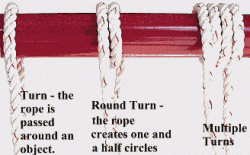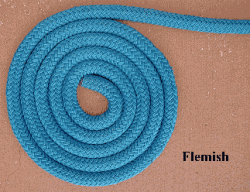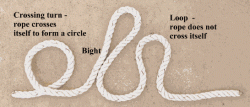A few Marlinspike knot tying terms from BoatSafe.com
Posted By RichC on May 8, 2018

Bitter end: the free end of a line
Standing part: the longer part of a line which is fixed during the tying of a knot
Bight: The part of the rope between the end and the standing part. A loop formed by folding the rope back on itself
Turn: a loop formed around a post, rail, or the line itselfCrossing Turn: a circle of rope made by crossing the rope over itself
Loop: a circle of rope made by bringing two parts of the rope together without crossing them over each other
Splice: weaving strands of a line to itself or to a second piece of line
Whipping: wrapping twine or tape around line to line’s end to prevent unraveling
Seizing: wrapping twine or tape around two lines to bind two parts of line side by side
Worming: laying smaller line in the spiral grooves (with the lay) between line strands
Parcelling: winding strips of canvas over, and in the same direction as, worming
Serving: winding small line against the lay and over worming and parcelling to protect line from chafe and water damage
Flemish: to make a Flemish coil by taking the end of a line and laying it in a tight flat spiral on the deck. Used to “tidy” up and keep line neat
Faking: laying a line on deck in a series figure eights so the line will run free without tangling
Flaking: laying out line on deck in parallel rows.
Short splice: the strongest way to connect two lines. This splice has 6 strands in the cross section and is thick and may not run through a block
Long splice: the strand of one line replaces the strand of the other line. The size of line is kept the same however, and it is weaker than the short splice
Eye splice: stronger than any knot in forming a loop in a line
Thimble: a metal or plastic form inserted in the eye splice to prevent chafe
Back splice: splicing a line back on itself to prevent unraveling – it like the short splice has a cross section of 6 strands and may not be able to be pulled through a block
Eye: A loop made in the end of a rope either by knotting, seizing or splicing.
Coil: Rope made into a neat series of loops or circles, usually for storing.
Source: Marlinespike – Terminology


Comments